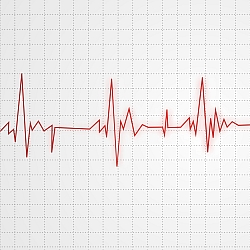Medical researchers at University of Rochester in New York, with computer scientists at IBM, built a computer model of the heart wall that can predict the risk of irregular heart rhythms and sudden cardiac death in patients. The results of this collaboration, led by Rochester cardiovascular professor Coeli Lopes, appear in a recent issue of the Journal of the American College of Cardiology (paid subscription required).
The researchers include Lopes’s colleagues from Rochester, as well as scientists from IBM’s research labs in Yorktown Heights, New York and Melbourne, Australia. Scientists from the University of Copenhagen in Denmark, the National Cardiovascular Center in Japan, the University of Amsterdam in the Netherlands, and the Lund University in Sweden participated in the research as well.
The researchers believe this is the first computer simulation that can predict the risk of cardiac arrhythmias, or heart rhythm disorders. “With this model,” says Lopes, “we can determine the influence of a single mutation on the much bigger overall response of the heart.” This proof-of-concept study, says the team, can lead to more complex models to calculate the consequences of genetic, lifestyle, and other changes to the heart.
The team developed a computer model of 192 heart cells programmed to function electrically like the ventricle wall of the heart. The program assigned properties to the cells based on their inside, middle, or outside position in the heart wall.
The IBM scientists started with canine cardiac cells, then adapted the model cells to act more like cells in human heart tissue based on extensive data on human heart electrical properties. To accommodate these properties, the model became quite complex. To simulate just one heartbeat requires the solution of more than 100,000 complex mathematical equations at least 1,000 times over.
The Rochester/IBM team tested the model with 600 people in the U.S., Japan, and Europe who have an inherited cardiac condition known as Long QT syndrome type 1 that puts patients at greater risk of arrhythmias and sudden cardiac death. Long QT syndrome type 1 is a result of mutations in the KCNQ1 gene, which helps heart cells generate and transmit appropriate electrical signals. Proteins were recreated in the lab for 34 mutations of the KCNQ1 gene to better understand how the mutated genes act and their effects.
The researchers ran the model on each mutation’s electrical profile to simulate the mutation’s effect on the heart wall. The model returned a one-dimensional electrocardiogram or ECG for each mutation for the heart wall that predicts the effect of the mutation on electrical properties of the heart wall as it is excited and relaxes after each beat.
Comparing the model’s results to data from the 600 patients predicted the mutations would prolong the time it takes for the heart wall to recover after each beat, known as repolarization, which would put patients at greater risk of potentially life-threatening events. The researchers suggest the computer simulation results point to more of a life-long, systemic risk of heart rhythm problems, which would not necessarily be diagnosed with a traditional ECG that tracks heart rhythms at a single point in time.
Jeremy Rice, the senior IBM author on the team with a background in cardiac modeling, says testing the model on a range of mutations makes the findings more valuable. “Oftentimes, scientists will study only one mutation at a time, and the research community remains unconvinced as the right answer may have come by luck,” notes Rice. “By comparing our results to so much patient data, we’ve shown that you can get meaningful information out of computer models, hopefully paving the way for wider acceptance and use in the medical community.”
In the following video, Lopes tells more about the research and the computer cardiac modeling.
- Simulations Helping Design Cardiac Pump Improvements
- Clinical Eye Testing Simulation Software Developed
- UC San Diego, Yale to Build Neuroscience Gateway
- Universal Vaccines Assessed for Widespread Flu Prevention
- Consortium Develops Virtual Mouse for Lab Testing
* * *


 RSS - Posts
RSS - Posts
You must be logged in to post a comment.